Accounting Policy Changes, Warranty, Intangible Assets Solutions
VerifiedAdded on 2023/06/05
|7
|1568
|241
Homework Assignment
AI Summary
This assignment provides solutions to accounting problems related to changes in accounting policies, warranty obligations, and intangible assets. It covers the circumstances under which an entity can voluntarily change its accounting policies, including requirements by standards or to provide a more reliable portrayal of financial statements. The solution demonstrates the retrospective application of accounting policy changes, including journal entries for machine revaluation and depreciation. It also addresses the recognition of warranty obligations as provisions, contingent liabilities, and the criteria for recognizing intangible assets under AASB 138, differentiating between internally generated and acquired intangible assets. Desklib offers a wealth of similar solved assignments and study resources for students.
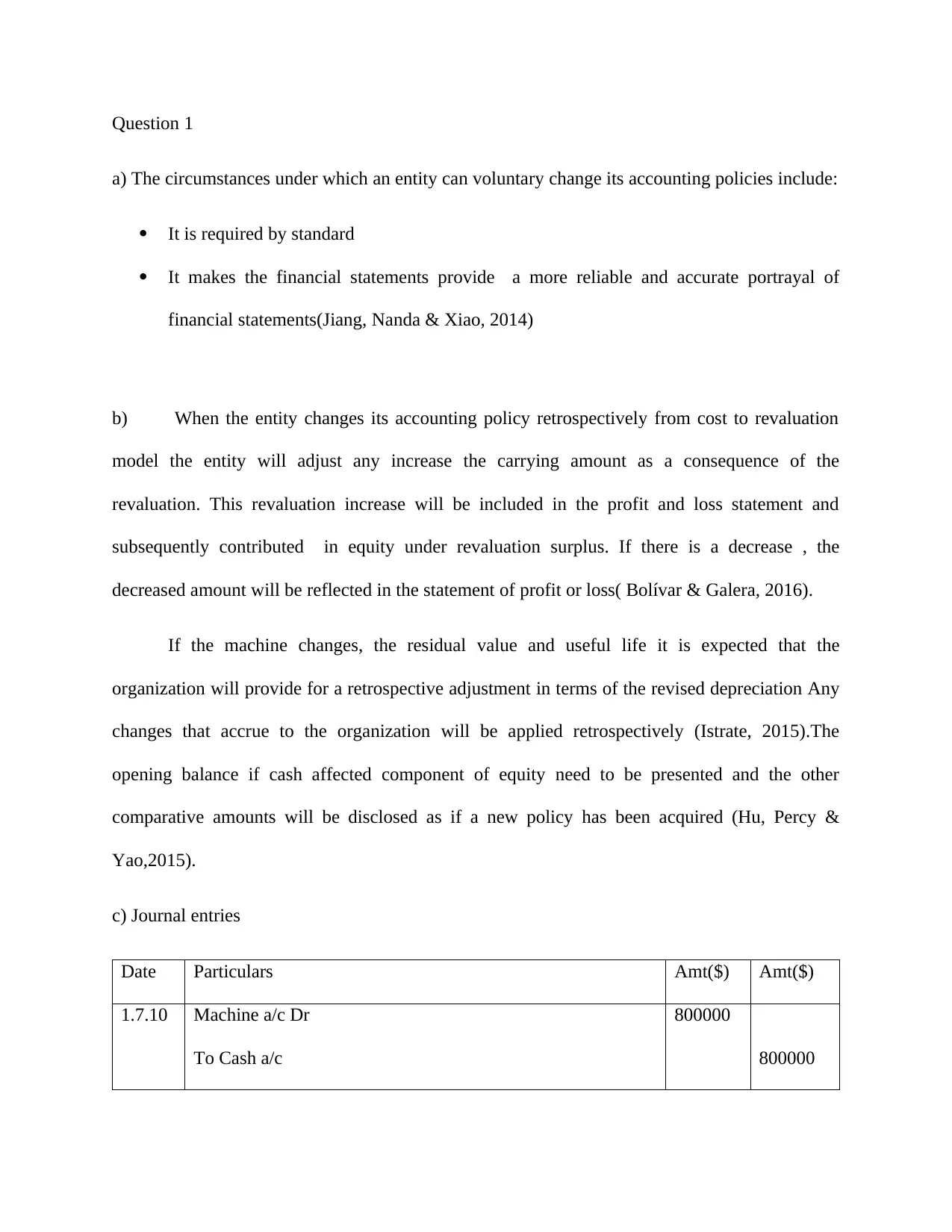
Question 1
a) The circumstances under which an entity can voluntary change its accounting policies include:
It is required by standard
It makes the financial statements provide a more reliable and accurate portrayal of
financial statements(Jiang, Nanda & Xiao, 2014)
b) When the entity changes its accounting policy retrospectively from cost to revaluation
model the entity will adjust any increase the carrying amount as a consequence of the
revaluation. This revaluation increase will be included in the profit and loss statement and
subsequently contributed in equity under revaluation surplus. If there is a decrease , the
decreased amount will be reflected in the statement of profit or loss( Bolívar & Galera, 2016).
If the machine changes, the residual value and useful life it is expected that the
organization will provide for a retrospective adjustment in terms of the revised depreciation Any
changes that accrue to the organization will be applied retrospectively (Istrate, 2015).The
opening balance if cash affected component of equity need to be presented and the other
comparative amounts will be disclosed as if a new policy has been acquired (Hu, Percy &
Yao,2015).
c) Journal entries
Date Particulars Amt($) Amt($)
1.7.10 Machine a/c Dr
To Cash a/c
800000
800000
a) The circumstances under which an entity can voluntary change its accounting policies include:
It is required by standard
It makes the financial statements provide a more reliable and accurate portrayal of
financial statements(Jiang, Nanda & Xiao, 2014)
b) When the entity changes its accounting policy retrospectively from cost to revaluation
model the entity will adjust any increase the carrying amount as a consequence of the
revaluation. This revaluation increase will be included in the profit and loss statement and
subsequently contributed in equity under revaluation surplus. If there is a decrease , the
decreased amount will be reflected in the statement of profit or loss( Bolívar & Galera, 2016).
If the machine changes, the residual value and useful life it is expected that the
organization will provide for a retrospective adjustment in terms of the revised depreciation Any
changes that accrue to the organization will be applied retrospectively (Istrate, 2015).The
opening balance if cash affected component of equity need to be presented and the other
comparative amounts will be disclosed as if a new policy has been acquired (Hu, Percy &
Yao,2015).
c) Journal entries
Date Particulars Amt($) Amt($)
1.7.10 Machine a/c Dr
To Cash a/c
800000
800000
Paraphrase This Document
Need a fresh take? Get an instant paraphrase of this document with our AI Paraphraser
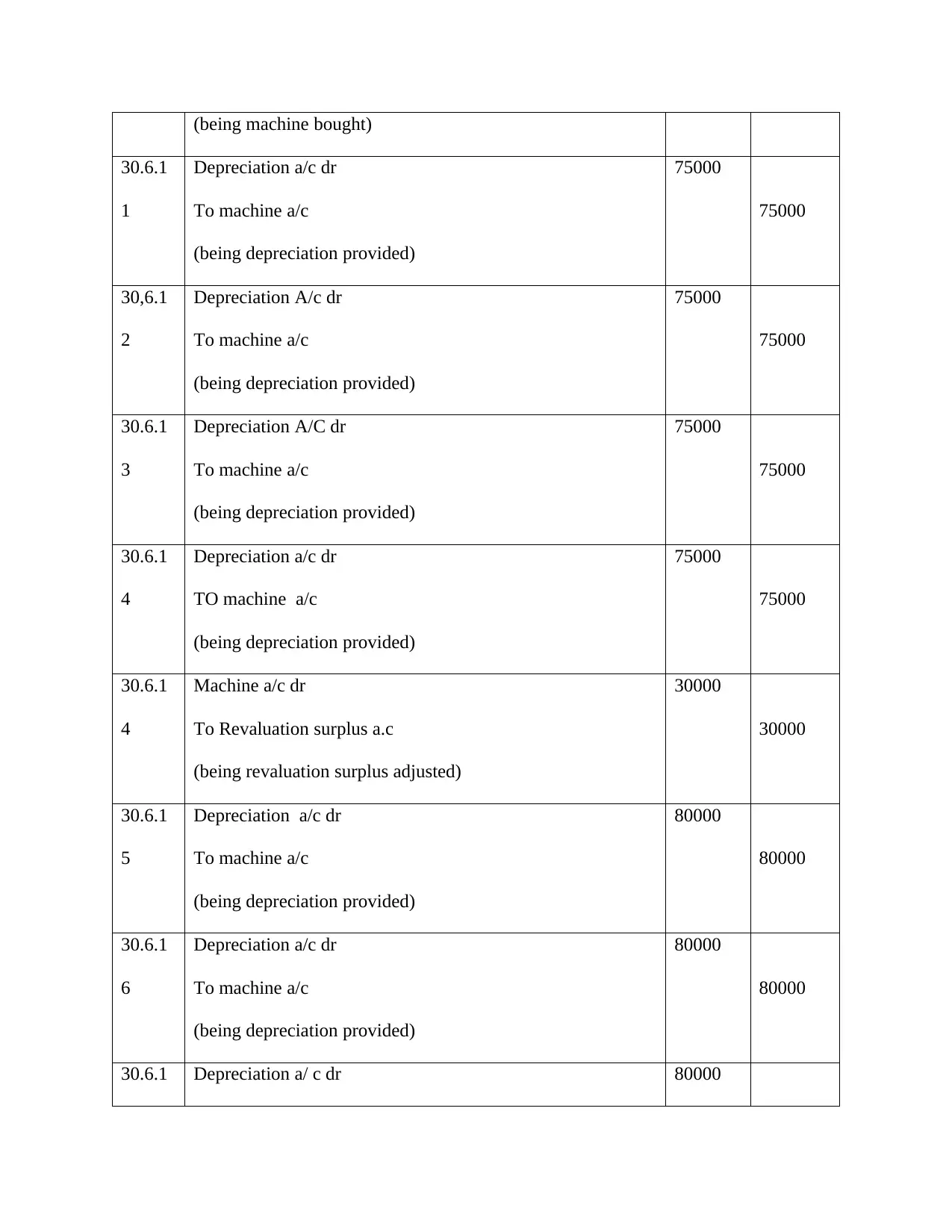
(being machine bought)
30.6.1
1
Depreciation a/c dr
To machine a/c
(being depreciation provided)
75000
75000
30,6.1
2
Depreciation A/c dr
To machine a/c
(being depreciation provided)
75000
75000
30.6.1
3
Depreciation A/C dr
To machine a/c
(being depreciation provided)
75000
75000
30.6.1
4
Depreciation a/c dr
TO machine a/c
(being depreciation provided)
75000
75000
30.6.1
4
Machine a/c dr
To Revaluation surplus a.c
(being revaluation surplus adjusted)
30000
30000
30.6.1
5
Depreciation a/c dr
To machine a/c
(being depreciation provided)
80000
80000
30.6.1
6
Depreciation a/c dr
To machine a/c
(being depreciation provided)
80000
80000
30.6.1 Depreciation a/ c dr 80000
30.6.1
1
Depreciation a/c dr
To machine a/c
(being depreciation provided)
75000
75000
30,6.1
2
Depreciation A/c dr
To machine a/c
(being depreciation provided)
75000
75000
30.6.1
3
Depreciation A/C dr
To machine a/c
(being depreciation provided)
75000
75000
30.6.1
4
Depreciation a/c dr
TO machine a/c
(being depreciation provided)
75000
75000
30.6.1
4
Machine a/c dr
To Revaluation surplus a.c
(being revaluation surplus adjusted)
30000
30000
30.6.1
5
Depreciation a/c dr
To machine a/c
(being depreciation provided)
80000
80000
30.6.1
6
Depreciation a/c dr
To machine a/c
(being depreciation provided)
80000
80000
30.6.1 Depreciation a/ c dr 80000
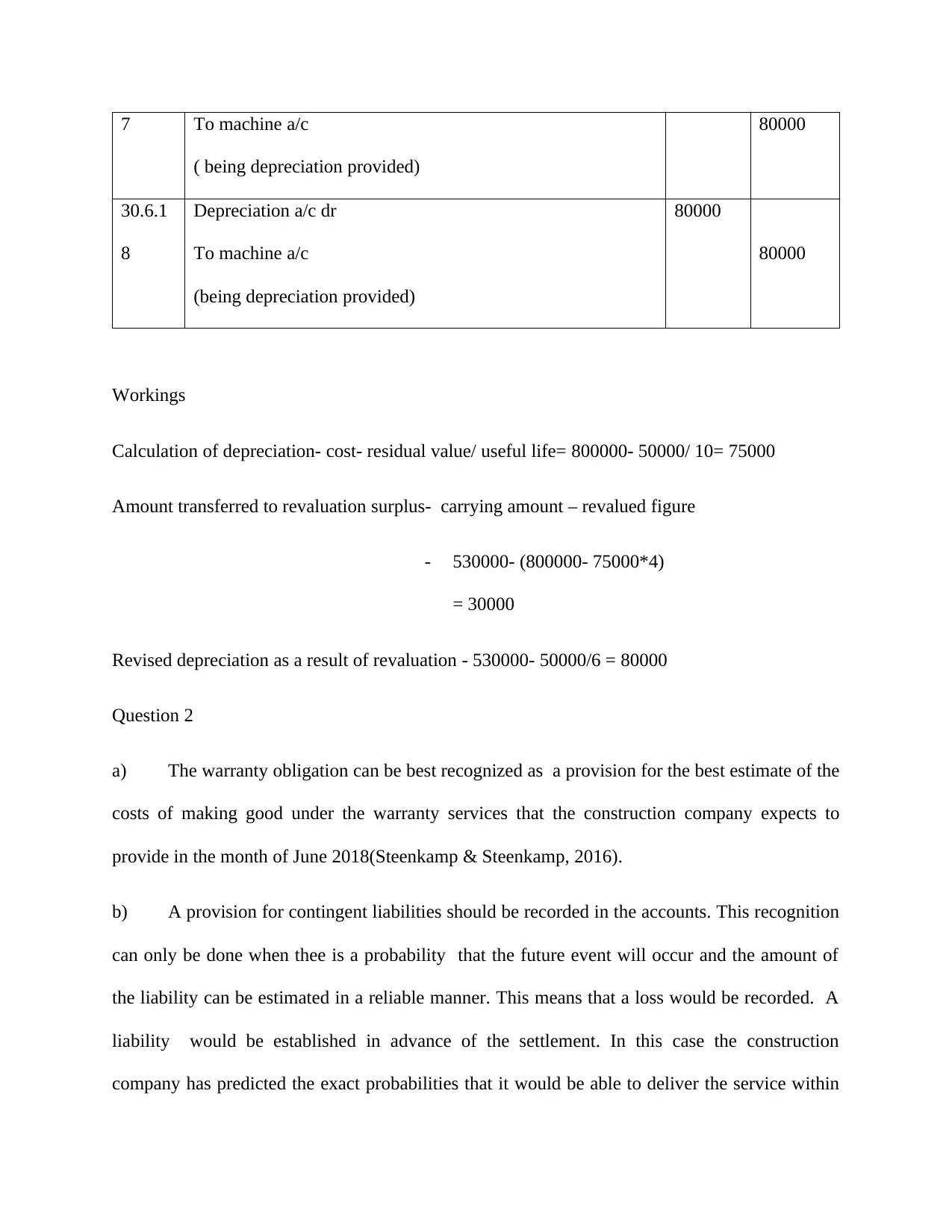
7 To machine a/c
( being depreciation provided)
80000
30.6.1
8
Depreciation a/c dr
To machine a/c
(being depreciation provided)
80000
80000
Workings
Calculation of depreciation- cost- residual value/ useful life= 800000- 50000/ 10= 75000
Amount transferred to revaluation surplus- carrying amount – revalued figure
- 530000- (800000- 75000*4)
= 30000
Revised depreciation as a result of revaluation - 530000- 50000/6 = 80000
Question 2
a) The warranty obligation can be best recognized as a provision for the best estimate of the
costs of making good under the warranty services that the construction company expects to
provide in the month of June 2018(Steenkamp & Steenkamp, 2016).
b) A provision for contingent liabilities should be recorded in the accounts. This recognition
can only be done when thee is a probability that the future event will occur and the amount of
the liability can be estimated in a reliable manner. This means that a loss would be recorded. A
liability would be established in advance of the settlement. In this case the construction
company has predicted the exact probabilities that it would be able to deliver the service within
( being depreciation provided)
80000
30.6.1
8
Depreciation a/c dr
To machine a/c
(being depreciation provided)
80000
80000
Workings
Calculation of depreciation- cost- residual value/ useful life= 800000- 50000/ 10= 75000
Amount transferred to revaluation surplus- carrying amount – revalued figure
- 530000- (800000- 75000*4)
= 30000
Revised depreciation as a result of revaluation - 530000- 50000/6 = 80000
Question 2
a) The warranty obligation can be best recognized as a provision for the best estimate of the
costs of making good under the warranty services that the construction company expects to
provide in the month of June 2018(Steenkamp & Steenkamp, 2016).
b) A provision for contingent liabilities should be recorded in the accounts. This recognition
can only be done when thee is a probability that the future event will occur and the amount of
the liability can be estimated in a reliable manner. This means that a loss would be recorded. A
liability would be established in advance of the settlement. In this case the construction
company has predicted the exact probabilities that it would be able to deliver the service within
⊘ This is a preview!⊘
Do you want full access?
Subscribe today to unlock all pages.

Trusted by 1+ million students worldwide
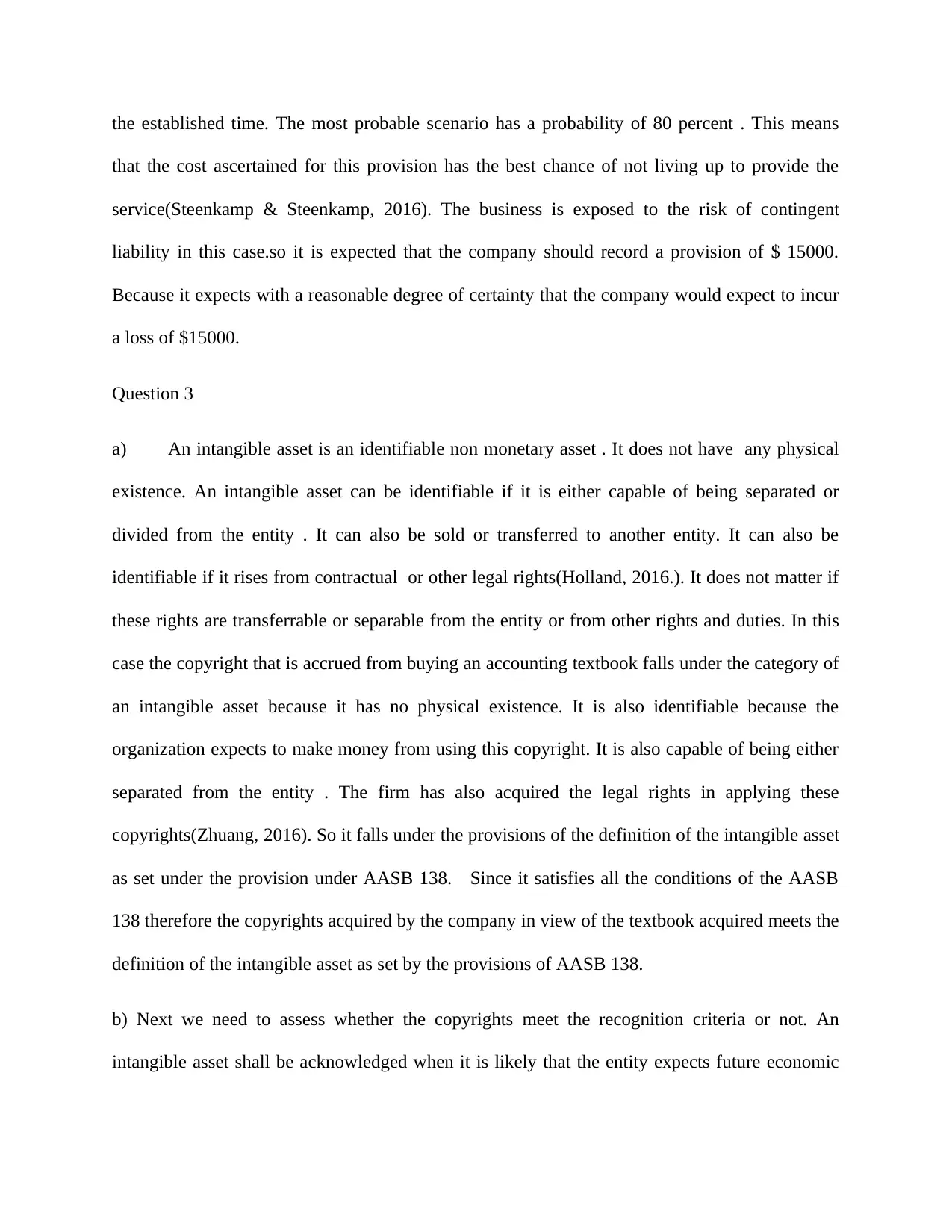
the established time. The most probable scenario has a probability of 80 percent . This means
that the cost ascertained for this provision has the best chance of not living up to provide the
service(Steenkamp & Steenkamp, 2016). The business is exposed to the risk of contingent
liability in this case.so it is expected that the company should record a provision of $ 15000.
Because it expects with a reasonable degree of certainty that the company would expect to incur
a loss of $15000.
Question 3
a) An intangible asset is an identifiable non monetary asset . It does not have any physical
existence. An intangible asset can be identifiable if it is either capable of being separated or
divided from the entity . It can also be sold or transferred to another entity. It can also be
identifiable if it rises from contractual or other legal rights(Holland, 2016.). It does not matter if
these rights are transferrable or separable from the entity or from other rights and duties. In this
case the copyright that is accrued from buying an accounting textbook falls under the category of
an intangible asset because it has no physical existence. It is also identifiable because the
organization expects to make money from using this copyright. It is also capable of being either
separated from the entity . The firm has also acquired the legal rights in applying these
copyrights(Zhuang, 2016). So it falls under the provisions of the definition of the intangible asset
as set under the provision under AASB 138. Since it satisfies all the conditions of the AASB
138 therefore the copyrights acquired by the company in view of the textbook acquired meets the
definition of the intangible asset as set by the provisions of AASB 138.
b) Next we need to assess whether the copyrights meet the recognition criteria or not. An
intangible asset shall be acknowledged when it is likely that the entity expects future economic
that the cost ascertained for this provision has the best chance of not living up to provide the
service(Steenkamp & Steenkamp, 2016). The business is exposed to the risk of contingent
liability in this case.so it is expected that the company should record a provision of $ 15000.
Because it expects with a reasonable degree of certainty that the company would expect to incur
a loss of $15000.
Question 3
a) An intangible asset is an identifiable non monetary asset . It does not have any physical
existence. An intangible asset can be identifiable if it is either capable of being separated or
divided from the entity . It can also be sold or transferred to another entity. It can also be
identifiable if it rises from contractual or other legal rights(Holland, 2016.). It does not matter if
these rights are transferrable or separable from the entity or from other rights and duties. In this
case the copyright that is accrued from buying an accounting textbook falls under the category of
an intangible asset because it has no physical existence. It is also identifiable because the
organization expects to make money from using this copyright. It is also capable of being either
separated from the entity . The firm has also acquired the legal rights in applying these
copyrights(Zhuang, 2016). So it falls under the provisions of the definition of the intangible asset
as set under the provision under AASB 138. Since it satisfies all the conditions of the AASB
138 therefore the copyrights acquired by the company in view of the textbook acquired meets the
definition of the intangible asset as set by the provisions of AASB 138.
b) Next we need to assess whether the copyrights meet the recognition criteria or not. An
intangible asset shall be acknowledged when it is likely that the entity expects future economic
Paraphrase This Document
Need a fresh take? Get an instant paraphrase of this document with our AI Paraphraser
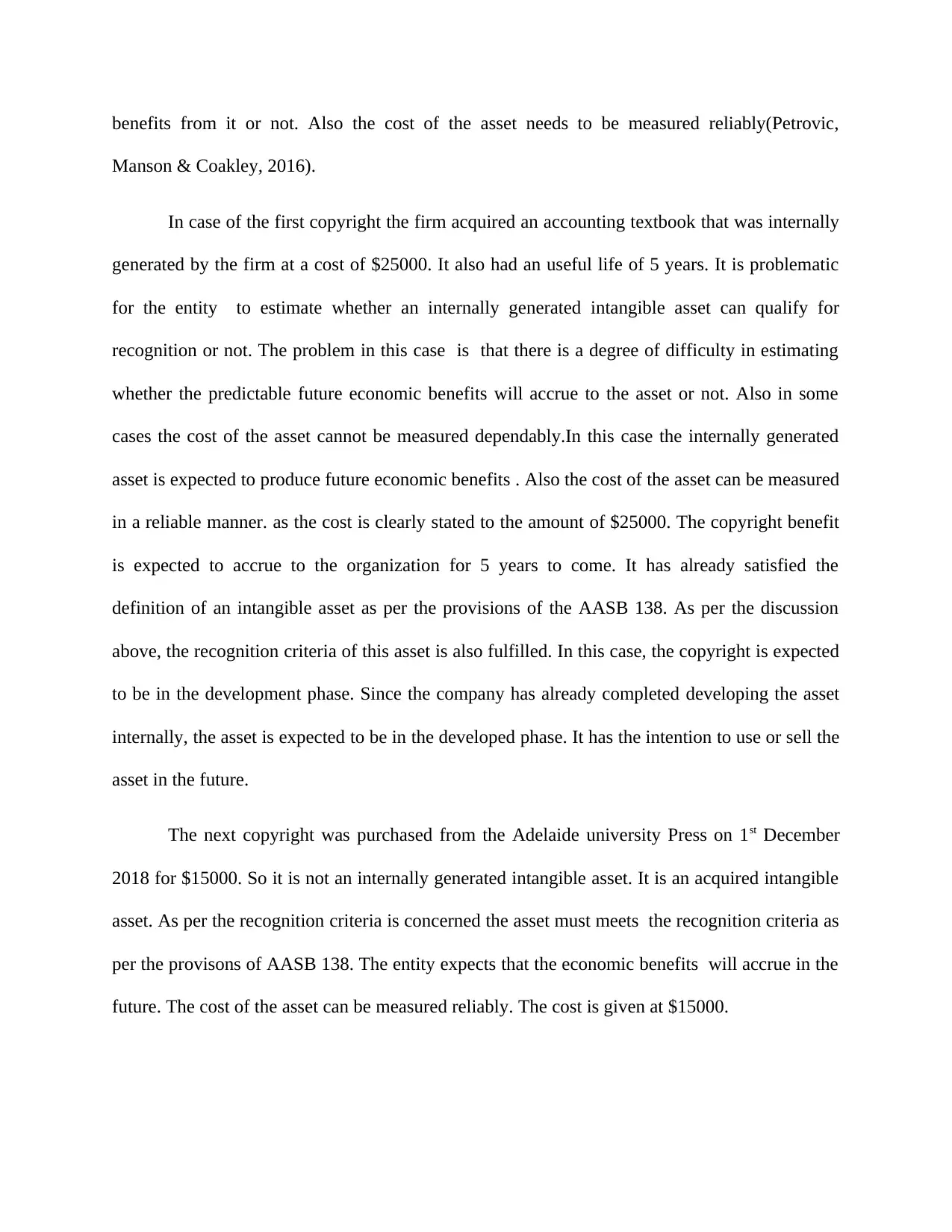
benefits from it or not. Also the cost of the asset needs to be measured reliably(Petrovic,
Manson & Coakley, 2016).
In case of the first copyright the firm acquired an accounting textbook that was internally
generated by the firm at a cost of $25000. It also had an useful life of 5 years. It is problematic
for the entity to estimate whether an internally generated intangible asset can qualify for
recognition or not. The problem in this case is that there is a degree of difficulty in estimating
whether the predictable future economic benefits will accrue to the asset or not. Also in some
cases the cost of the asset cannot be measured dependably.In this case the internally generated
asset is expected to produce future economic benefits . Also the cost of the asset can be measured
in a reliable manner. as the cost is clearly stated to the amount of $25000. The copyright benefit
is expected to accrue to the organization for 5 years to come. It has already satisfied the
definition of an intangible asset as per the provisions of the AASB 138. As per the discussion
above, the recognition criteria of this asset is also fulfilled. In this case, the copyright is expected
to be in the development phase. Since the company has already completed developing the asset
internally, the asset is expected to be in the developed phase. It has the intention to use or sell the
asset in the future.
The next copyright was purchased from the Adelaide university Press on 1st December
2018 for $15000. So it is not an internally generated intangible asset. It is an acquired intangible
asset. As per the recognition criteria is concerned the asset must meets the recognition criteria as
per the provisons of AASB 138. The entity expects that the economic benefits will accrue in the
future. The cost of the asset can be measured reliably. The cost is given at $15000.
Manson & Coakley, 2016).
In case of the first copyright the firm acquired an accounting textbook that was internally
generated by the firm at a cost of $25000. It also had an useful life of 5 years. It is problematic
for the entity to estimate whether an internally generated intangible asset can qualify for
recognition or not. The problem in this case is that there is a degree of difficulty in estimating
whether the predictable future economic benefits will accrue to the asset or not. Also in some
cases the cost of the asset cannot be measured dependably.In this case the internally generated
asset is expected to produce future economic benefits . Also the cost of the asset can be measured
in a reliable manner. as the cost is clearly stated to the amount of $25000. The copyright benefit
is expected to accrue to the organization for 5 years to come. It has already satisfied the
definition of an intangible asset as per the provisions of the AASB 138. As per the discussion
above, the recognition criteria of this asset is also fulfilled. In this case, the copyright is expected
to be in the development phase. Since the company has already completed developing the asset
internally, the asset is expected to be in the developed phase. It has the intention to use or sell the
asset in the future.
The next copyright was purchased from the Adelaide university Press on 1st December
2018 for $15000. So it is not an internally generated intangible asset. It is an acquired intangible
asset. As per the recognition criteria is concerned the asset must meets the recognition criteria as
per the provisons of AASB 138. The entity expects that the economic benefits will accrue in the
future. The cost of the asset can be measured reliably. The cost is given at $15000.

⊘ This is a preview!⊘
Do you want full access?
Subscribe today to unlock all pages.

Trusted by 1+ million students worldwide
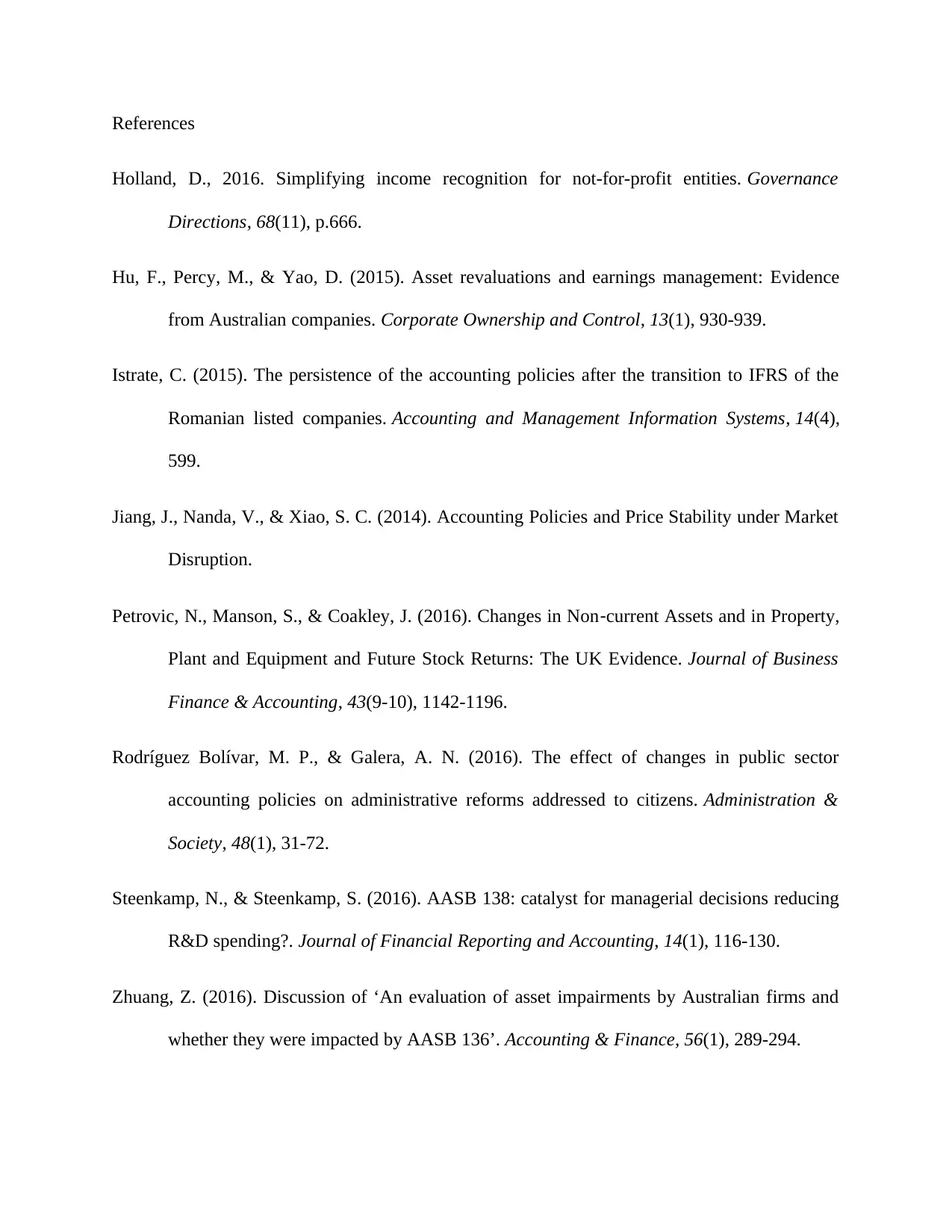
References
Holland, D., 2016. Simplifying income recognition for not-for-profit entities. Governance
Directions, 68(11), p.666.
Hu, F., Percy, M., & Yao, D. (2015). Asset revaluations and earnings management: Evidence
from Australian companies. Corporate Ownership and Control, 13(1), 930-939.
Istrate, C. (2015). The persistence of the accounting policies after the transition to IFRS of the
Romanian listed companies. Accounting and Management Information Systems, 14(4),
599.
Jiang, J., Nanda, V., & Xiao, S. C. (2014). Accounting Policies and Price Stability under Market
Disruption.
Petrovic, N., Manson, S., & Coakley, J. (2016). Changes in Non‐current Assets and in Property,
Plant and Equipment and Future Stock Returns: The UK Evidence. Journal of Business
Finance & Accounting, 43(9-10), 1142-1196.
Rodríguez Bolívar, M. P., & Galera, A. N. (2016). The effect of changes in public sector
accounting policies on administrative reforms addressed to citizens. Administration &
Society, 48(1), 31-72.
Steenkamp, N., & Steenkamp, S. (2016). AASB 138: catalyst for managerial decisions reducing
R&D spending?. Journal of Financial Reporting and Accounting, 14(1), 116-130.
Zhuang, Z. (2016). Discussion of ‘An evaluation of asset impairments by Australian firms and
whether they were impacted by AASB 136’. Accounting & Finance, 56(1), 289-294.
Holland, D., 2016. Simplifying income recognition for not-for-profit entities. Governance
Directions, 68(11), p.666.
Hu, F., Percy, M., & Yao, D. (2015). Asset revaluations and earnings management: Evidence
from Australian companies. Corporate Ownership and Control, 13(1), 930-939.
Istrate, C. (2015). The persistence of the accounting policies after the transition to IFRS of the
Romanian listed companies. Accounting and Management Information Systems, 14(4),
599.
Jiang, J., Nanda, V., & Xiao, S. C. (2014). Accounting Policies and Price Stability under Market
Disruption.
Petrovic, N., Manson, S., & Coakley, J. (2016). Changes in Non‐current Assets and in Property,
Plant and Equipment and Future Stock Returns: The UK Evidence. Journal of Business
Finance & Accounting, 43(9-10), 1142-1196.
Rodríguez Bolívar, M. P., & Galera, A. N. (2016). The effect of changes in public sector
accounting policies on administrative reforms addressed to citizens. Administration &
Society, 48(1), 31-72.
Steenkamp, N., & Steenkamp, S. (2016). AASB 138: catalyst for managerial decisions reducing
R&D spending?. Journal of Financial Reporting and Accounting, 14(1), 116-130.
Zhuang, Z. (2016). Discussion of ‘An evaluation of asset impairments by Australian firms and
whether they were impacted by AASB 136’. Accounting & Finance, 56(1), 289-294.
1 out of 7
Related Documents
Your All-in-One AI-Powered Toolkit for Academic Success.
+13062052269
info@desklib.com
Available 24*7 on WhatsApp / Email
![[object Object]](/_next/static/media/star-bottom.7253800d.svg)
Unlock your academic potential
Copyright © 2020–2025 A2Z Services. All Rights Reserved. Developed and managed by ZUCOL.





